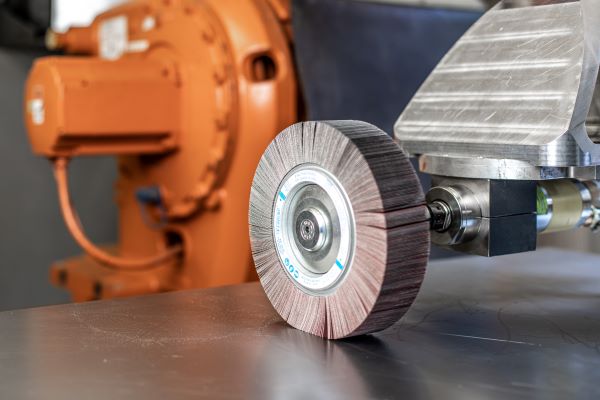The use of robotics in manufacturing continues to grow at a rapid rate as businesses invest in automation to remain competitive. A shortage of skilled labour and a shift towards low-margin, high-volume models are fuelling this need to automate. However, while more and more manufacturers are investing in robotic applications, many are not realising the full benefits of the technology, including increased productivity, improved quality, better efficiencies, and cost savings, because they are failing to pair the technology with equally high-performing consumables.
According to the latest World Robotics Report, the top five industries for robotic adoption include electronics, automotive, metal and machinery, plastic and chemicals, as well as the food industry. Technological advancements and the proliferation of robot technologies mean that robots are more cost-effective and easier to use than ever before. Given their ability to work alongside humans and perform complementary tasks, collaborative robots (cobots) have ensured that robotic technology is within reach even for smaller businesses.
The advantage of robotic applications is that they improve the overall efficiency and effectiveness of the manufacturing process by reducing manual work and delivering consistent results in shorter cycles. When choosing a robot, the most suitable is the one that can achieve productivity gains and meet the technical requirements of the application. Other considerations are safety, space utilisation, upfront investment and after-sales support.
The types of processes that are suitable for automation in the industrial sector are repetitive tasks that require precise movements, consistent accuracy, as well as tasks that are too dangerous or strenuous for humans to complete. Selecting the most appropriate robot for an industrial application requires weighing up different attributes and criteria. Typically, the selection criteria will be based on application, reach, payload capacity, number of axes, precision, repeatability and mounting position, amongst others, all of which needs to be weighed up against production demands, manufacturing systems design and economic impact.
Dennis Phillips, National Sales Manager at PFERD-South Africa, reveals that when implementing robotic applications, it’s crucial to pair this high-performance equipment with equally high-performing consumables if the aim is to optimise processes, reduce costs and improve overall operational efficiency. “One of the biggest mistakes businesses make is that they combine a high-performing robot asset with sub-standard consumables, making it harder for the asset to reach its full potential and deliver repeatable efficiencies.”
One of the benefits of robotic and automated processes is consistency. Surface finishes, for example, are reproducible by programming the robot with the same parameters repeatedly. Phillips explains that when a sub-standard abrasive is incorporated, the robot will be incapable of producing this consistency. “This is because sub-standard or low-cost consumables don’t go through the stringent manufacturing processes and quality controls as, for instance, PFERD’s abrasives do.”
Every production manager’s worst nightmare is unscheduled downtime which is why robots must be relatively easy to operate, repair and maintain. One of the consequences of incorporating sub-standard or incorrect consumables is decreased productivity. “If the robot is paired with the incorrect consumables, downtime will increase due to the low or reduced service life of standard products resulting in regular stoppages to change out the used consumables. This can massively impact the equipment’s output,” says Phillips.
PFERD tools can be used in a variety of robotic applications, including milling, cutting, grinding, brushing and polishing processes. The company’s team of Application Specialists are available to assess customers’ robotic applications and advise on the optimum and most cost-effective tool and tool drive combinations.
PFERD’s professional tools for robotic and automated processes include:
- Milling, drilling, and countersinking tools: PFERD Milling tools are ideally suited for robot applications because of their dimensional stability and long tool life. Their Tungsten Carbide Burrs, for example, are available in various industry-required shapes and sizes. PFERD’s TC burrs are highly suited to the demands of robotic applications due to their precision, high aggressiveness, and extended service life.
- Fine grinding and polishing tools: PFERD offers a wide range of tools suitable for numerous automated fine grinding and polishing tasks—from improving surfaces and surface roughness to cleaning, deburring, and final polishing.
- Diamond and CBN tools: Used on robots for applications including machining grey and nodular cast iron components and fibre-reinforced plastics. These PFERD tools offer constant tool geometry and a variety of shapes and grits which makes them ideal for robot applications in demanding applications or industries.
- Industrial power brushes: PFERD offers a specialised range of Composite filament brushes ideally suited for a wide range of robotic applications. A benefit of Composite brushes, when compared with traditional wire brushes, is their cool grinding capability and lack of sparks. Unlike steel, stainless steel and brass wire brushes the risk of material contamination is also greatly reduced.
“Composite brushes have been specifically developed for industrial, automated use. These brushes are particularly suitable for deburring complicated components such as cylinder heads and gear toothing and are approved for high-tech industries such as aviation and power generation” explains Phillips.
- Robot spindles for stationary applications
PFERD manufactures a range of high-performance robot spindles—adhering to the latest performance and technology standards—designed for seamless integration into industry-standard robots. Users who require tailored spindle solutions for specialised robotic tasks are encouraged to contact PFERD as they can provide custom spindle solutions to fit a customer’s unique needs. PFERD offer users the ideal combination of innovative abrasives, high-performance tool drives and the technical expertise to help customers get the most out of their robot applications.
PFERD understands the impact of being an active team player, valuing coordination and leveraging years of experience to provide technical assistance to the industry. In the area of successful robotics, industry specialists unite, forming a cohesive chain of collective achievement.
“We encourage customers to contact us to assist in determining and finding the most cost-effective solution for each specific application to ensure their investment and operations reach their full potential,” says Phillips. “Ultimately, it’s about helping our customers use robotic technology to become more efficient, grow their productivity cost-effectively and get more done with less.”









